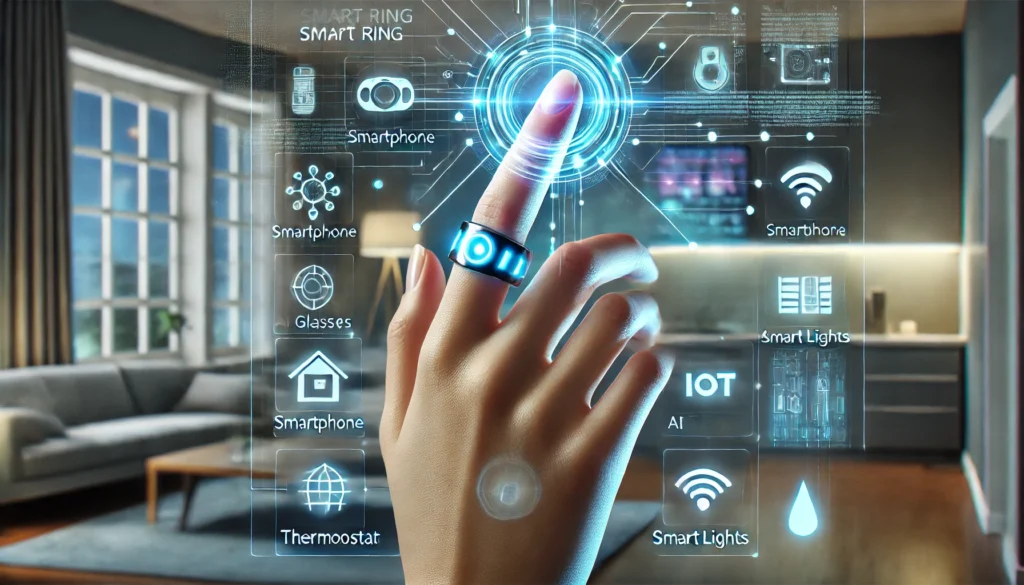Imagine composing a message by tracing letters on your palm, adjusting your smart thermostat with a flick of your wrist, or silencing an incoming call on your AI glasses with a subtle pinch. This isn’t just futuristic speculation—it’s the promise of FRinger, a Smart AI Ring defined by OpenWing.ai, revolutionizing human-machine interaction. While smartwatches and AR glasses dominate the wearable conversation, FRinger pioneers a new paradigm: an AI-driven, gesture-controlled ring that eliminates reliance on screens, buttons, and voice commands. By integrating AI-powered gesture recognition, haptic feedback, and seamless connectivity, FRinger serves as an intelligent bridge between humans and the AIoT ecosystem.
The FRinger Revolution: From Fitness Trackers to AIoT Command Hubs
Traditional smart rings, such as the Oura Ring or Circular, focus on health metrics like sleep tracking and heart rate monitoring. FRinger reimagines this form factor as an AIoT command hub, leveraging advanced motion sensors—accelerometers, gyroscopes, and infrared detectors—to interpret micro-gestures with precision. These components distinguish deliberate actions from accidental movements, while integrated haptic feedback mimics physical interactions for intuitive control. Projects like Stanford’s FingerT9 prototype laid the groundwork for gesture-based input, but FRinger’s AI algorithms take it further by contextualizing gestures—allowing users to trace a “@” symbol to tag locations in AR glasses or rotate an invisible dial to adjust smart home devices. Early NFC-enabled rings hinted at the potential, but FRinger’s fusion of AI and IoT positions it as a universal AIoT controller.
AIoT Synergy: Your Finger as an Intelligent Interface
FRinger thrives in a connected AIoT ecosystem. Bluetooth Low Energy (BLE) enables efficient communication with smartphones and AR glasses, while Ultra-Wideband (UWB) provides spatial awareness—point at a lamp to toggle it, or “grab” a holographic menu item in mid-air. When paired with AI glasses like Meta’s Ray-Bans, FRinger unlocks new possibilities: pinch your thumb and middle finger to capture AR-enhanced photos, flick your wrist to scroll through virtual dashboards, or assign custom gestures to automate routines like “work mode” (adjusting lighting and notifications). OpenWing.ai’s AI agent ecosystem enhances this experience by allowing users to personalize FRinger’s functionalities, enabling developers to integrate bespoke AI assistants tailored to individual needs and environments.
Use Cases: Expanding the AIoT Landscape
In professional settings, FRinger enhances productivity. Surgeons can navigate 3D medical scans mid-surgery without breaking sterility, while engineers can manipulate CAD models using finger-swipes in AR environments. Everyday interactions become more intuitive—adjusting your thermostat with a simple dial motion or receiving discreet haptic notifications from AI glasses. For accessibility, FRinger serves as a transformative tool—enabling individuals with motor impairments to control wheelchairs via gesture presets or neurodiverse users to “type” messages on their palms, reducing sensory overload. By integrating with OpenWing.ai’s AIoT marketplace, users can extend FRinger’s capabilities with AI agents that personalize interactions based on contextual learning and adaptive feedback.
Challenges: Innovation vs. Practicality
Despite its promise, FRinger faces challenges. Power efficiency remains a concern, as AI-driven gesture processing requires sustained energy. Advancements like kinetic energy harvesting or solar-charging coatings could address this. Security is another critical factor—encrypted gesture data and biometric authentication (e.g., heartbeat signatures) will be essential to prevent unauthorized control of AIoT devices. Design-wise, balancing sensor density with wearability is crucial—modular approaches, like Cnick’s flexible rings, present a viable path forward. User adoption will also depend on intuitive learning models; FRinger’s AI adapts to individual gesture patterns, reducing the need for extensive memorization and making AIoT interactions more natural.
The Future: AIoT and the Next Evolution of Wearables
FRinger represents just the beginning of AI-driven wearables. Apple’s gesture-controlled AR/VR ring patents and Samsung’s rumored Galaxy Ring (2024) signal industry-wide momentum. With the advent of 6G networks, cloud-based AI processing could further minimize hardware constraints, while brain-computer interfaces (BCIs) may eventually pair with FRinger for subconscious control. OpenWing.ai’s vision aligns with this evolution—enabling a future where AIoT devices seamlessly integrate with AI agents, transforming everyday objects into intelligent interfaces. The ultimate goal? A world where technology dissolves into the background, allowing users to engage naturally with their environment through AI-enhanced wearables.
Conclusion: The Finger as the Future of AIoT Interaction
FRinger exemplifies the next stage in human-computer interaction: no screens, no buttons, no audible commands—just intelligent, intuitive control at your fingertips. As AIoT ecosystems mature, wearable AI agents will redefine how we interact with technology, making devices like FRinger an essential interface for the connected world. The future of AI-driven wearables isn’t limited to your wrist or voice—it’s on your finger, seamlessly integrating AIoT intelligence into every gesture.


